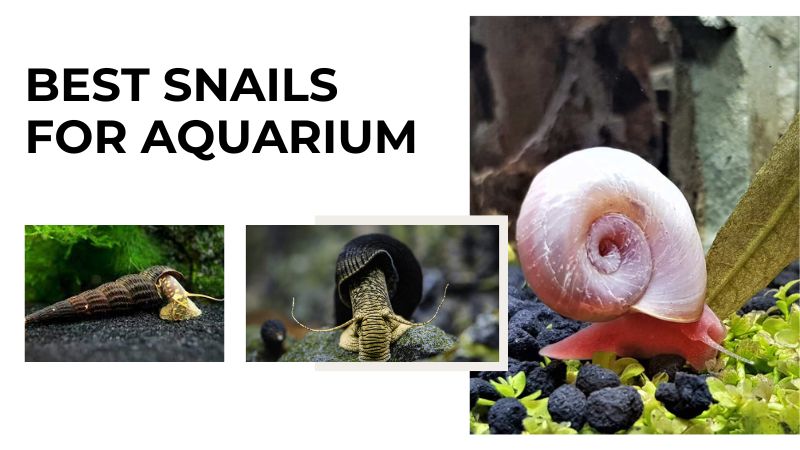Aquarium snails often get overlooked in favor of more glamorous fish, but they play crucial roles in maintaining the health and cleanliness of your tank. They can control algae, consume uneaten food, and even aerate the substrate. Below, Tropical Fish Haven will introduce the best snails for aquarium and how to care for them.
The Best Snails for Aquarium
Nerite Snails (Neritina spp.)
Appearance: Nerite snails are renowned for their visually striking shells, which feature intricate patterns in an array of colors including black, brown, gold, and even green. Their shells often showcase eye-catching zebra or tiger stripe patterns, making them a popular choice for aquarists seeking both function and aesthetic appeal. The variety of patterns and colors available ensures that Nerite snails can add a touch of unique beauty to any aquarium setting.
Benefits: One of the most significant advantages of keeping Nerite snails is their exceptional ability to consume algae. They efficiently clean glass, rocks, and decorations, helping to keep the aquarium environment free of unwanted algae growth. Additionally, Nerite snails do not reproduce in freshwater conditions, which eliminates the risk of overpopulation—a common issue with many other snail species. This makes them an ideal choice for those who want the benefits of snail algae control without the hassle of managing a rapidly increasing snail population.
Care: Nerite snails are adaptable to a wide range of water conditions but thrive best in water with a pH level between 7.5 and 8.5. They require a stable environment with consistent water parameters to avoid stress and health issues. It’s crucial to ensure that there are no gaps or openings in the aquarium cover, as Nerite snails have a tendency to escape. Regularly check the tank for potential escape routes to keep them safely contained. Providing a diet that includes algae wafers and occasional vegetables can help supplement their nutritional needs, especially in tanks with insufficient natural algae.
Mystery Snails (Pomacea bridgesii)
Appearance: Mystery snails, also known as apple snails, are notable for their vibrant and varied color palette. They come in hues ranging from golden yellow and ivory white to shades of blue, purple, and even black. Their large, rounded shells and prominent operculum (a protective plate) make them easily distinguishable and add a splash of color to any aquarium.
Benefits: These snails are excellent scavengers, consuming uneaten fish food, plant matter, and detritus. This helps maintain water quality and reduces waste accumulation. Mystery snails are also known for their engaging behaviors, such as climbing tank walls and exploring the substrate. Their active and curious nature makes them a fascinating addition to the aquarium.
Care: Mystery snails prefer water with a pH range of 7.0 to 7.5 and temperatures between 68°F to 82°F (20°C to 28°C). They require calcium-rich foods or supplements to ensure proper shell growth and maintenance. This can be provided through specialized snail foods, blanched vegetables like zucchini and spinach, or cuttlebone placed in the tank. Regular water changes and monitoring of water quality are essential to keep them healthy and thriving.
Malaysian Trumpet Snails (Melanoides tuberculata)
Appearance: Malaysian trumpet snails are easily recognizable by their elongated, conical shells, which typically range in color from light brown to grey. Their shells are often adorned with subtle, spiral ridges, adding to their distinctive appearance. They are relatively small, making them a discreet yet functional addition to the aquarium.
Benefits: These snails are particularly valued for their role in aerating the substrate. As they burrow through the gravel or sand, they help prevent the buildup of anaerobic pockets, which can release harmful gases if disturbed. They are also efficient detritivores, consuming leftover food, decaying plant material, and organic debris, thereby contributing to a cleaner and healthier tank environment.
Care: Malaysian trumpet snails are highly adaptable and can thrive in a wide range of water conditions, from soft to hard water and varying pH levels. However, they are prolific breeders, so their population should be monitored to prevent overcrowding. Regular substrate vacuuming and manual removal of excess snails can help manage their numbers. Providing a balanced diet that includes algae wafers and blanched vegetables can support their nutritional needs.
Rabbit Snails (Tylomelania spp.)
Appearance: Rabbit snails are named for their long, spiral shells that resemble the ears of a rabbit. These snails come in various colors, including shades of yellow, brown, black, and even orange. Their shells have a textured, rugged appearance, and they have a distinctive, elongated body that moves slowly and deliberately.
Benefits: Rabbit snails are effective cleaners, consuming algae and detritus. Their slow movement and unique foraging behavior make them an interesting species to observe. Unlike many other snail species, rabbit snails reproduce slowly, laying single eggs that take time to hatch. This controlled reproduction rate reduces the risk of overpopulation.
Care: These snails prefer warmer water temperatures, ideally between 76°F to 84°F (24°C to 29°C), and a pH range of 7.2 to 8.0. They require a calcium-rich diet to maintain healthy shells, which can be provided through supplements or calcium-enriched foods. Ensure the tank has plenty of hiding spots and soft substrates to accommodate their burrowing habits. Regular water changes and stable water parameters are essential for their well-being.
Assassin Snails (Clea helena)
Appearance: Assassin snails are easily identified by their attractive, banded shells, which feature alternating stripes of yellow and brown. Their elongated, conical shells and pointed spires give them a distinctive and striking look. They are relatively small, making them suitable for various tank sizes.
Benefits: Assassin snails are highly valued for their ability to control pest snail populations. They are carnivorous and prey on other snails, including those that can become problematic in the aquarium. This natural method of population control helps maintain a balanced ecosystem without the need for chemical treatments.
Care: Assassin snails thrive in water with a pH range of 7.0 to 8.0 and temperatures between 70°F to 82°F (21°C to 28°C). They are relatively easy to care for and do not reproduce rapidly, making them a manageable addition to the tank. However, if the pest snail population diminishes, ensure they have an adequate food source, such as protein-rich pellets or meaty foods. Providing a well-maintained and stable environment will support their health and longevity.
Bladder Snails (Physella acuta)
Appearance: Bladder snails are small and typically have translucent, amber-colored shells that are oval and slightly pointed. Their shells are delicate and smooth, with a subtle sheen that catches the light. They are one of the more common snail species found in aquariums.
Benefits: Bladder snails are effective algae eaters and scavengers, consuming uneaten food and organic debris. This helps maintain water quality and reduces the accumulation of waste. Their small size allows them to access and clean hard-to-reach areas of the tank, contributing to overall cleanliness.
Care: Bladder snails are extremely hardy and can adapt to a wide range of water conditions, from soft to hard water and varying pH levels. They reproduce quickly, so their population needs to be monitored to prevent overcrowding. Regular tank maintenance, including substrate vacuuming and manual removal of excess snails, can help manage their numbers. Providing a diet that includes algae wafers and vegetable matter can support their health and well-being.
General Care Tips for Aquarium Snails
Water Quality: Maintaining good water quality is crucial for the health of aquarium snails. Perform regular water changes, monitor parameters such as pH, temperature, and hardness, and ensure a stable environment.
Diet: Provide a balanced diet that includes algae wafers, blanched vegetables, and calcium supplements to support healthy shell growth and overall health.
Population Control: Some snail species reproduce rapidly. Implement measures such as adding snail predators or manually removing excess snails to manage their populations effectively.
Avoid Copper: Copper is toxic to snails. Avoid using medications or supplements containing copper in tanks housing snails to prevent harm to these sensitive creatures.
By selecting the right snail species for your aquarium and providing proper care, you can enjoy the benefits of these fascinating and functional creatures while maintaining a healthy and balanced aquatic environment.
Conclusion
Adding snails to your aquarium can bring numerous benefits, from controlling algae to aerating the substrate. Each species has unique characteristics and care requirements, so choose the ones that best fit your tank’s conditions and your personal preferences. With proper care, snails can be a fascinating and beneficial addition to your aquatic ecosystem.





